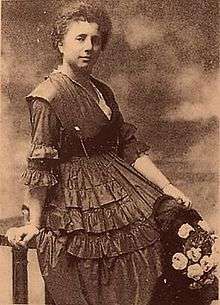Margherita Sarfatti
| Margherita Sarfatti | |
|---|---|
 | |
| Born |
Margherita Grassini April 8, 1880 Venice, Kingdom of Italy[1] |
| Died |
October 30, 1961 (aged 81) Cavallasca, Italy |
| Nationality | Italian |
| Occupation | Author, journalist, art critic |
| Known for | Being the mistress of Benito Mussolini |
| Notable work | The Life of Benito Mussolini (1925) |
| Political party | National Fascist Party |
| Religion | Judaism |
| Spouse(s) | Cesare Sarfatti (1902-1924, his death) |
| Parent(s) |
|
Margherita Sarfatti (April 8, 1880 – October 30, 1961) was an Italian journalist, art critic, patron, collector, socialite, a prominent propaganda adviser of the National Fascist Party. She was Benito Mussolini's biographer as well as one of his mistresses.
Biography
Margherita Sarfatti was born Margherita Grassini, in Venice, the daughter of Amedeo Grassini and Emma Levi. Amedeo was a wealthy Jewish lawyer and businessman. He was a fiscal attorney for the Venetian government and a close friend of Giuseppe Melchiorre Sarto, later Pope Pius X. He would later be made a Knight of the Order of the Crown of Italy.[2]
Sarfatti grew up in a palazzo situated at the Canal Grande in Venice and was educated by private tutors. However, she was soon attracted by socialist ideas and escaped her parents' home at age 18 to marry Cesare Sarfatti, a Jewish lawyer from Padua. He was 13 years her senior, but shared her socialist beliefs.[1] In 1902, the couple moved to Milan.[2] There, they became prominent in the city's artistic life, hosting weekly Salons that became the centre of the Futurist and Novecento Italiano artistic movements.[3] They had several children. Their eldest son, Robert, enlisted in the Italian army during World War 1, but was killed in action on Monte Baldo in January 1918, aged 18.[1]
In 1911, Margherita Sarfatti met Benito Mussolini (three years her junior) and started a relationship with him. After losing her husband in 1924, she wrote a biography of Mussolini. This first published in 1925 in Britain under the title The Life of Benito Mussolini; it was published the following year in Italy with the title Dux. Because of the fame of Mussolini and the author's familiarity with the dictator, the book was a success. Seventeen editions were printed and it was translated into 18 languages.
Until 1938, when Mussolini bowed to German pressure and after the Manifesto of Race enacted a racial legislation, Fascist ideology was free of any elements of anti-Semitism, and the party's membership rolls were open to Jews.[4] Probably in reaction to the changing circumstances in Italy, Sarfatti left Italy in 1938 for Argentina and Uruguay; she worked as a journalist in the newspaper El Diario of Montevideo.[5] After the war, in 1947, Sarfatti returned to her home country and once again became an influential force in Italian art.
In popular culture
Actress Susan Sarandon portrayed Sarfatti in the 1999 movie Cradle Will Rock which was written and directed by Sarandon's then longtime companion, Tim Robbins. Sarandon discussed her role, saying:
Margherita is someone who is a legitimate historical figure. She really existed. She really was Mussolini's mistress and was very involved in the cultural shaping of Italy's art movements. She was a patron of new painters in Italy. She came over to the United States to sell Mussolini to the American people, and she did that by using Hearst's column. She wrote a column, and that was how they prepared the United States people for the concept of entering the war on the side of Mussolini, I suppose. And also she was trying to fund the war.
And the complication of this was the fact that she was Jewish, and she in fact was facilitating her own crisis, which eventually would make her flee the country and live in Argentina, I believe, for a number of years before it was safe for her to go back. Whether or not she was just in complete denial or she really truly believed that there was a way to sleep with Mussolini and not be held accountable, I don't know. But she ended up in an awkward position. She was hobnobbing with all these rich American people. I think in the context of the film, she's somebody who has a job to do and because she loved art, she sometimes finds herself to be giving all this art away to people she feels don't really appreciate it.
References
- 1 2 3 Colussi, Paolo. "Margherita Sarfatti e il "Novecento"" (in Italian). Storia di Milano. Retrieved 22 May 2014.
- 1 2 Acobas, Patrizia (2010). "Margherita Sarfatti 1880-1961". Jewish women: A comprehensive historical encyclopedia. Retrieved 2012-07-16.
- ↑ Mane, Saviona (6 July 2006). "The Jewish mother of Fascism". Haaretz. Tel Aviv. Retrieved 23 May 2014.
- ↑ "Italian Fascism Didn't Practice Anti-Semitism". The New York Times. December 22, 1993.
- ↑ Gilbert, Isidoro (February 10, 2007). "La amante judía de Mussolini que vivió en Montevideo" [Mussolini's Jewish mistress who lived in Montevideo] (in Spanish). LR21.
Further reading
- Cannistraro, Philip, and Brian R. Sullivan. Il Duce's Other Woman: The Untold Story of Margherita Sarfatti, Mussolini's Jewish Mistress, 1993. ISBN 0-688-06299-7
- Urso, Simona. Margherita Sarfatti. Dal mito del Dux al mito americano, 2003. ISBN 88-317-8342-4
- Wieland, Karin. Die Geliebte des Duce. Das Leben der Margherita Sarfatti und die Erfindung des Faschismus, 2004. ISBN 3-446-20484-9
- Sarfatti,Margherita. The Life of Benito Mussolini, 1925; 2004. ISBN 1-4179-3962-1
- Gutman, Daniel. El amor judío de Mussolini, 2006. ISBN 987-603-017-5
- Liffran, Françoise. Margherita Sarfatti, L'égérie du duce, Biography, 2009. ISBN 978-2-02-098353-2
External links
- A caricature by David Levine
- Cradle Will Rock at the Internet Movie Database
- Mussolinis Femme-Fatale, New York Review of Books, July 15, 1993

